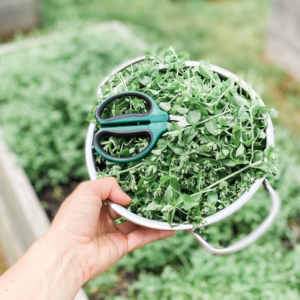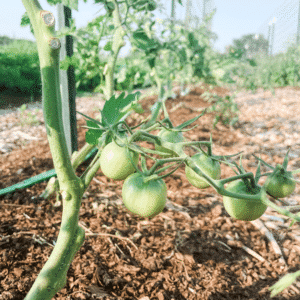How to Get Rid of Vine Borers for Good

Plan your best garden with simple, step-by-step instructions!
This post may contain affiliate links, which means I make a small commission at no extra cost to you.
See my full disclosure here.
Ready to get rid of vine borers for good?
There’s nothing quite so discouraging as watching a perfectly healthy zucchini plant wilt before your eyes, while you stand by, helpless. If you have trouble with vine borers, I’ve got good news and bad news.
2017 Update: Oh, the irony. Gardening sure has a way of keeping us humble, doesn’t it? The method described below has worked well for us for a number of years, but this year we’re experiencing a few snags. Be sure to read my update at the end of this post…
2022 Update: We moved to a 20-acre farm in 2018 and again had trouble with SVBs. In 2022 I finally cracked the code on successfully growing squash without chemicals (and without squash vine borers!). Hooray! Get all the details here: How to Overcome Squash Vine Borers Without Chemicals.
First, the Bad News
Once a vine borer damages your plant, there’s really not much you can do. It’s almost impossible to save a plant infested with a vine borer.
What happened was this: an adult vine borer layed an egg at the base of your healthy zucchini plant. About a week later, the egg hatched and the larva drilled into your zucchini stem, munching its way up the inside of the vine.
You had no idea this was happening until one morning when you went outside and noticed your formerly robust zucchini plant suddenly looking wilted and then yellowing. The damage occurs so quickly that by the time the gardener realizes it, most plants are beyond repair.
If your plant isn’t heavily damaged, you can take a shot at saving it. Act fast! Start by slitting the vine from the entry site (which you’ll identify by the yellowish sawdust-like “frass” left behind at the base of the plant) until you locate the larva. Remove and destroy the vine borer.
Rinse the surgery site well with water, then pack good soil around it and wrap with something like tin foil or panty hose. If that part of the vine is laying on the ground, you can simply pile mulch over it. More great instructions here.

Zucchini and watermelon plants, both protected with my simple method.
Now for the Good News
The good news has two parts.
1. Do not despair! You can plant again.
In most regions, you can plant a second round of zucchini in early July and still get a good harvest later in the growing season. Act quickly if planting from seed. Better yet, check your local nurseries for leftover squash transplants.
From what I understand of the vine borer’s life cycle, squash planted later in the growing season like this (early July) should not be affected by this pest. By the time these plants mature, adult vine borers will be finished laying their eggs. Hooray!

2. Here’s the best part: vine borers are 100% preventable.
I’ll show you how we have successfully warded off vine borers in our garden for the past several years. It’s so easy!
If you lost some plants to vine borers, don’t beat yourself up. It happens to most gardeners at least once! Just don’t let it happen to you again. Be smarter than the vine borer, friends.

How to Get Rid of Vine Borers for Good
Are you ready for this? Here is the solution to vine borer trouble: Dixie cups.
Yep, all you need is one 5 oz. paper cup per plant. I’ll show you my simple method in the video below, or you can simply follow these instructions:
- We follow this method for all vining crops. Zucchini usually takes the hardest hit, but we play it safe by protecting melons, cucumbers, pumpkins, and winter squash too.
- Timing is important. Wait until seedlings are a few inches tall, but still small enough to fit through the cup. It’s also best if the ground is soft and wet, like after a rain.
- Remove the bottom of each paper cup. I like to make a slit with a sharp utility knife, then use my fingers to pull the round bottom out of the cup.
- Gently push one hollow cup around each seedling, carefully wiggling it down into the ground.
- That’s it! Leave the cup there all throughout the growing season.

- I should also mention this Easy Garden Spray we use on our zucchini plants to ward off squash bugs. It’s possible the spray is also effective against vine borers, so I recommend using both methods just to be safe!
UPDATE: Just yesterday, the very day before this blog post was scheduled to be published, we discovered vine borer damage to two of our otherwise healthy zucchini plants. Noooooo!
It’s ironic, because I had just asked Mr. Native Texan, What is it about the cups that keeps the moths from laying eggs on the stem? Couldn’t they still get down inside the cups? We weren’t sure, but for some reason, we’ve had very little trouble with vine borers since we started using the cups. So we shrugged it off. If it ain’t broke, don’t fix it.

Well. Now that we’ve lost a few plants to vine borers, even with the cups, here are a few observations, preliminary conclusions, and a game plan for moving forward.
1. Peppermint Oil Garden Spray
We’re now pretty confident that our Garden Spray with Peppermint oil was making a much bigger difference than we realized. This year our zucchini crop is planted in an entirely different area of the garden. Because of the new location, it’s harder to access the base of the plants.
In previous years, our squash was planted in raised beds, with a garden walkway directly behind the plants. That made it much easier to spray the entire plant, including the base of the stems.
This year we also haven’t sprayed as proactively as we did over the past several years. You’d better believe we’ll be spraying future squash plants like it’s our job.

2. Surgery
I don’t have high hopes, because we’ve tried it before with little success. But we’re a little smarter this time, with more experience under our belts, and really, what do we have to lose? We plan to slit the stems of any affected vines, locate and destroy those blasted little worms, and cover the surgery sites as best we can.
3. Replanting
It’s still the first half of July, so we plan to plant another crop of zucchini if necessary. As I mentioned above, we hope to get around the vine borer’s life cycle by planting later in the season.
4. Stem Wiping
In my research to find effective, organic methods for vine borer control, I’ve come across a few intriguing ideas. Going forward, and especially beginning today with our Pumpkin, Spaghetti Squash, and Blue Hubbard Squash seedlings, I plan to wipe down each stem with a rag soaked in water and Peppermint & Thyme essential oils. According to my research, this should be done at least every five days but I plan to do it daily-ish.

5. Stem Wrapping
The Dixie cups were a good start, but we plan to take it a step further by wrapping the stem itself with a material like gauze bandage rolls.
6. Yellow Bowls
Apparently the adult moth is attracted to the color yellow (hello, squash blossoms). Much anecdotal evidence online shows some success in using yellow bowls of water to trap adult vine borer moths. Simply set out yellow bowls of water in the garden and the moths will fly to the bowls and then drown.
7. Tilling Under
According to Abby Seaman at Cornell University’s New York State Integrated Pest Management Program, affected crops should be tilled under immediately after harvest. Somehow this helps to prevent buildup of potentially damaging populations like the vine borer. I definitely don’t want these little buggers overwintering in the soil, so we’ll be following Abby’s advice.

8. Chickens
You’d better believe we’ll be releasing the chickens in that area this fall and next spring. I hope they find and destroy every single larvae and pupae in the soil.
We gardeners are a resilient bunch, and now I am more determined than ever to outsmart these nasty vine borers with completely organic methods. Hopefully we won’t lose any more zucchini plants to the dreaded borers, but with two plants lost already, I’m not holding my breath. Time will tell.
Stay tuned for updates on our battle against the vine borers!
2022 Update: We moved to a 20-acre farm in 2018 and again had trouble with SVBs. In 2022 I finally cracked the code on successfully growing squash without chemicals (and without squash vine borers!). Hooray! Get all the details here: How to Overcome Squash Vine Borers Without Chemicals.

Sign up NOW for my best tips delivered weekly to your inbox!
You’ll also get instant access to my library of free ebooks and resources.









No! You didn’t get hit, oh the irony, sorry! Tried to do surgery on my one last squash plant but the angle was bad and had to move the already weak vine and snapped off :-P. Need to replant, but so hard to see it go with so many budding blooms… thanks for sharing everything!
I know. Thankfully we’ve already harvested a bunch of zucchini, and we lost only two plants. Many more plants left…hoping they survive! We’re ready to plant a second crop if necessary. Good luck if you replant! 🙂
What a great idea. Now that we have space, and sun, for more gardening I may have to try zucchini next year.
Yes, you should. Hooray for more sun and space for gardening!
Vine bores have been pestering my garden for 4 years now so I hope this work next year
Good luck, Hunter!
I’ve been battling borers since 2012. Tried spraying the vines with various organic sprays and wrapping with foil. Each year they get worse. I can’t grow any squash anymore except patty pan and even that gets hit but I at least get some squash from it, Tromboncino holds up pretty good against borers but it needs a long growing season so must be started inside as early as possible. Otherwise I only get a few squash by the time frost hits, then right at the end of the season it makes a bunch of flowers too late. I am beginning to believe the only way to defeat borers is with non-organic methods unfortunately. I’m going to try Monterey’s Fruit Tree and Veg Soil Drench next year and see if that helps. It works systemically. They don’t say it works for squash borers, only for cane borers but maybe it will work on the newly hatched ones that are just entering the vine.
Ugh, Patricia, don’t you hate vine borers?? We are still battling them too.
Another idea instead of using dixie cups -When u are done with your roll of toilet paper, don’t throw out the card board roll.I have used this left over toilet paper roll to cover my squash stems.You can also use paper towel rolls, just shorten them.
Your paper cups are a nice idea. In theory. You probably never had many borers in the first place, this way thinking your method works.
While the larvae eat into the base of the stem, however, the borer doesn’t necessarily lay the egg there. It may. And just as likely it wit lay an egg each on the underside of each leaf stalk, on the leaves, on the underside of the leaves and even on the fruit. So by protecting the base only, a vine borer will certainly lay eggs on other parts of the plant.
I know, Ute! I’ve now progressed to growing zucchini & squash under row covers until the plants are quite large and flowering. This year I’m getting a decent harvest so far (it’s currently mid-July) and am hopeful to harvest more before potential problems with borers. Fingers crossed!
Can you clarify the proportions of water, peppermint oil and thyme oil that you use, and what is the peppermint spray you use? Do you have a recipe for that as well?
Also, in your experience, are the larger, or more mature squash vines any more resistent to the borers?
Hi Laurie, The peppermint spray is linked in the post, and here: Easy Garden Spray. For wiping the stems, it’s a very loose formula. I’d aim for 10 drops of each oil in a cup or two of water.
And unfortunately, borers can, and often do, attack larger, more mature squash vines.
Thank you for this article! I planted my first garden this year & just discovered I have vine borers this morning. I’m so upset! I remember seeing that “weird-looking bug” in my garden, but I had no idea what it was. Now I know! I think I caught the larvae early & will try to cut them out, but I’m prepared to have to replant & will definitely be using your tips & the spray.
Good luck, Rachel! 🙂
Kathleen, I have the Doterra oils. I just need to know how many drops per pint, if you would, please.
Hi David, The peppermint spray is linked in the post, and here: Easy Garden Spray. For wiping the stems, it’s a very loose formula. I’d aim for 10 drops of each oil in a cup or two of water.
There arent many organic ways to rid yourself of svb’s, they will lay there eggs on any one of the leaf stalks and burrow there way into the vines.one way, is to search through the plants and look for the eggs, they can lay upto 200 in there lifetime. I grow competion pumpkins and i have to use imidicloprid insecticide.
I bought several yellow beach pails at the dollar store to use as a decoy. It works out well. As for the paper cup at the base or aluminum foil, any kind of physical barrier to stop the moth from laying eggs on the base of the stem is helpful.
You can cut above the affected area of the plant, remove affected area, keep the part above it, remove all but a few leaves, put rooting hormone on the base though this may not be necessary. Plant in wet potting soil in filtered light. Keep moist but not soggy. In a week or so it will grow new leaves. Mine produced flower buds a week or so later. Plants root easily.
Wow, that’s amazing! You replant right into the ground, or into a pot and then transplant after roots develop?
The old folks here in NM say to plant zucchini on July 4. Then you miss the moths. But I can’t wait that long… so I used row covers this year until mid July. Seemed to work so far!
I used row cover last year, too. It was kind of a pain, but the zucchini was worth it. 🙂
I accidentally discovered that spaghetti squash vines seem to be protected from vine borer by growing in a dense bed of pachysandria. Or at least so far this summer for me. I had a vine attacked by borers over almost it’s entire length, but not the portion growing inside a dense bed of pachysandria. I think it’s just mechanical. The vine is near the earth and totally obscured and covered by pachysandria leaves. But the leaves of the vine are taller than the pachysandria and get the light they need. Flowers are pollinated and bear fruit. But perhaps the moth cannot see the vine or penetrate the canopy of dense leaves. The summer isn’t over but so far so good within pachysandria.
What a great discovery! 🙂
1st – Thanks for the paper cup idea, I will try this next year. I typically start my plants indoors. Have you or anyone else tried starting the plant in the cup? Have you ever had a problem with the paper cup restricting the plant?
I’ve struggled with squash vine borers for the past 4 years with zucchini. I tried cups and sprays, but they were still a problem. Far too late in the season two years ago, I read about a way to possibly save a plant that has them, so I tried it. It involved spraying the plant with Bt (bacillus thuringiensis), an organic bacteria that kills the SVB larvae, and also injecting it into the stems. I tried it then, but it was way too late to save them.
When I saw the plants wilting last year I injected a diluted Bt solution into the stems, then buried the parts where the borers had been, and the plant not only rebounded, but continued to produce zucchini for another month. It worked!
I’m going to move them to a different spot in the garden and try netting this year, so hopefully won’t have to use it. But that is the only thing I’ve found that will kill them and save the plant if you find it early enough!
I am moving from NJ to SC in two weeks. Every year I end of replacing all of my plants with new because of the vine borer. Zucchini and Spaghetti Squash are always destroyed by mid July!! This year in SC I am going to try the method of wrapping the base with aluminum foil and Sevin Dust them at the base. I am also thinking about putting yellow cups out and coating them with this sticky stuff. Can’t remember what it is but it is like bug glue. I will start with one and see how they work! I am also going to try the cups along with the aluminum foil. Can’t hurt to double down on these destructive creatures!
I have sprinkled cinnamon at the base of my zucchini plants, redoing after large rains or every couple of weeks and I have had no problems with borers, works on cucumbers too
Would nematodes help with these?